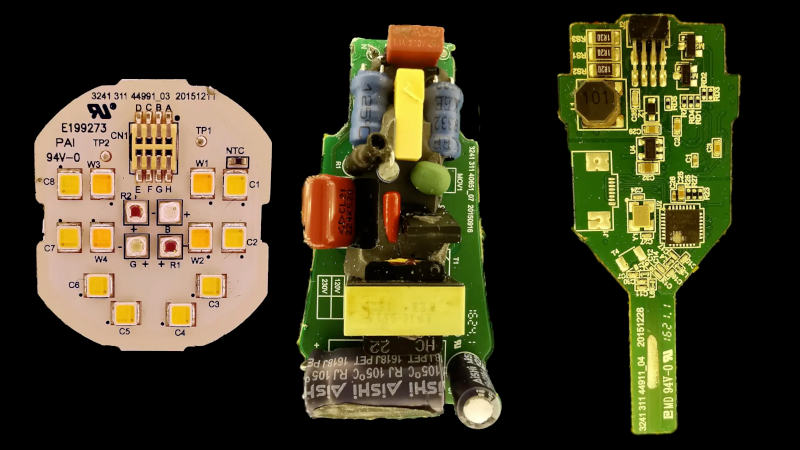What do you do with a Hue smart lightbulb? Well, if you are [Chris Greening], you take it apart and get hacking. If you ever wondered what’s inside, the teardown is pretty good, and you can also watch the video below. The potting compound, however, makes a mess.
Once you get the potting undone, there are three PCBs: an LED carrier, a power supply, and a logic board. The arrangement of the LEDs is a bit confusing, but [Chris] explains it along with providing schematics for all of the boards.
The odd LED arrangement allows the logic board to short out banks of LEDs. The next step was to hijack the RGB signals to allow an external microcontroller to take charge of the bulb. One LED driver chip drives everything. Shorting out banks with a cheap MOSFET allows one chip to drive the LEDs in multiple colors.
This is an interesting look inside a production smart bulb. We aren’t sure we’d really want to reuse one of these, but maybe if you had a bad power board, it would be better than trashing the relatively expensive bulbs.
We’ve seen other lights hacked to work with Hue. You can even hack together your own bridge if you like.
















Very clever way of driving 5 channels of LEDs with a single constant current power supply. I’ve always thought each channel was driven by simply a pwm signal with a feedback or something.
I did something similar a few years back but in reverse. I wanted a variable load, I settled on some filament lightbulbs, in series, with bypass switches across them, along with a couple of high current dimmer switches, again with bypass switches, one in series the other in parallel, for finer adjustment. A bit overkill, but it fit nicely on a large chopping board, once all the cables were wrapped in bundles, it came out relatively tidy. As long as there’s enough resistance to keep the dimmers happy, it’ll even cope well with inductive loads. Adding a few spur boxes to hide the joins and a plug and socket finished it off quite nicely. It’s not going to pass safety regulations, but it’s a good tool when required.
Interesting construction. But given how expensive these lights are, an off-brand capacitor in the PSU is a strange and unpleasant sight.
I would very much prefer to use the Hue system instead of my current WiZ lights, but all the Hue stuff is just too insanely overpriced for what it is.
“I would very much prefer to use the Hue system instead of my current WiZ lights, but all the Hue stuff is just too insanely overpriced for what it is.”
To have a preference means there is something you want – whether it’s the hardware, the software, the ecosystem or whatever….which is why it commands a price premium. To someone who really wants whatever it is that Hue offers, it is not overpriced.
This is coming from someone who tried all the major and a lot of the minor brands of smart lighting – Hue just frickin works, the signee implementation is sold, the hardware is quality, and the support is good. So I pay slightly more because I like my lights to work so I can hack on less wife-annoying parts of home automation.
signees is autocorrect’s version of “zigbee”…
I have 12 hue lights. Had 4 wiz lights which were so terrible i got rid of them. I prefer hue. I buy hue. But still think they are overpriced. I’m quite certain the markup is several hundred percent. I’d buy 30 more of they were half the cost
So much this. We have over 40 hue bulbs in our house (high ceilings, lots of recessed cans with BR65 bulbs. All color) and it was crazy expensive but everything works. Always. It is certainly a “buy once, cry once” thing. Especially when changing a bulb is a life threatening task.
[Chris] does the opposite of what’s described in the 3rd paragraph. He uses the bulb’s microcontroller to drive LEDs of his own.
I’ve got a Hue go that is not working. Can it be repaired?
Anything and everything can be repaired. It’s just a question of how much effort you want to put into it. Based on seeing in the video how difficult the bulb is to get into, I’d say that repair is probably not worth your time, unless you enjoy that sort of thing.
Now if only somebody could hack the firmware so they ran PWM at a much higher frequency, instead of 1kHz…
I had to ditch my Hue bulbs because they made me feel sick whenever they were on!
Makes me feel that you could wire this up to a raspberry, which could then send signals to wled for instance. Could be very cool for all addressable led type projects, while maintaining basic controls through hue.
Thinking for instance of a staircase, in/off/colour by hue, animation and such through wled.
Understand that wled can integrate with hue but only through polling the bridge through wifi. This would be neater.
If only i was better in practise than in theory.
Not sure why you would want to add hue there, an MCU, home assistant on the pi and then you have all the control you could want.
Using hue as the top layer would just make it more difficult for less function?
And home assistant can natively control hue so you can just skip the hue part (and use any hue lights as wireless lights anyway ;)